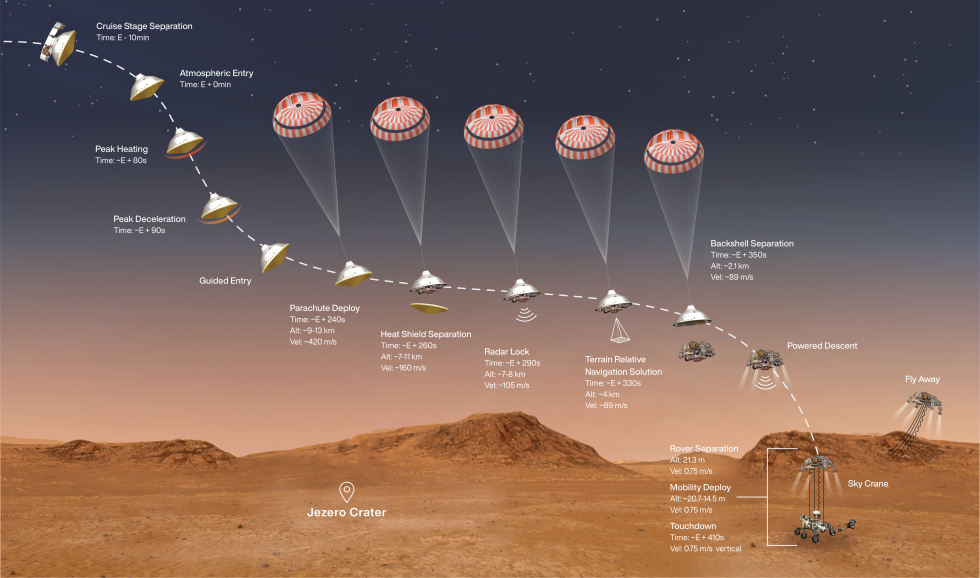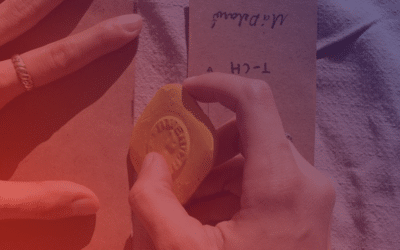Por: Eric Berger
Thursday’s the big day. NASA’s multibillion-dollar Mars rover will arrive at the red planet and almost immediately begin the process of trying to set down safely on the surface.
This is easier said than done. On approach to Mars, the Perseverance rover will shed its cruise stage, retaining only an aeroshell to protect itself and a descent stage. This slimmed-down spacecraft will hit the atmosphere traveling at about 20,000km/hour and have just 410 seconds—or nearly seven minutes—to shed this velocity and make a feathery touchdown.
How to land on Mars
Though the Martian atmosphere is thin, it will nonetheless provide a majority of the resistance to slow Perseverance down. Within about 80 seconds of entering the Martian atmosphere, temperatures outside the aeroshell are expected to reach 1300° Celsius.
About four minutes after encountering the atmosphere, the vehicle’s parachutes will deploy. Shortly after, the protective aeroshell will fall away, its job done. Then, when the vehicle descends to about 4km above the planet’s surface, it will activate its Terrain Navigation System. Up until this point, Perseverance’s trip will be very similar to that of the Curiosity rover, which underwent a similar «seven minutes of terror» during its successful landing in August 2012.
With Perseverance, there is one key difference—whereas Curiosity sought a safe landing site in the relatively smooth terrain of the Gale crater, this spacecraft will land in the Jezero crater, a more hazardous location with boulders. This location should make for richer scientific exploration. To mitigate the risk, engineers added a new system to allow for a more precise landing.
As the Perseverance descends, an onboard computer will begin to rapidly take pictures of the Martian surface, looking for features such as craters, cliffs, and large boulders to compare against previously captured orbital imagery. After the onboard computer has made 15 landmark «matches,» it will switch to a higher-resolution imaging mode to fine-tune the landing positioning. Curiosity could estimate where it was on Mars to within about 3km. Perseverance will bring this error down to 40 meters.
Upon reaching an altitude of 2km, the rover will begin a powered descent, followed by the «skycrane» maneuver to set Perseverance down on Mars at a velocity of less than 1m/s.
When will we know if Perseverance made it? Cameras on board the spacecraft will record its descent, but there will be no ability to relay this data in real time, and it will be sent a few days later. Because there is an 11-minute time delay between Earth and Mars at present, we won’t know the spacecraft’s fate until after it has touched down (or left a smoking hole in the surface of Mars). Touchdown is scheduled for about 3:55pm EST (20:55 UTC). With luck, a signal from the spacecraft will arrive on Earth, telling us all is well.
NASA television will provide live coverage on all the usual places beginning at 2:15pm EST (19:15 UTC) Thursday. So many people at NASA and in the industry have worked extraordinarily hard to make Thursday a success. Let’s hope they are rewarded.
A highly complex mission
Perseverance has a lot in common with Curiosity in other ways. Both were built from the same design and share many common parts. But NASA learned from Curiosity about the vehicle’s performance on Mars—such as the need for more durable aluminum wheels—and because of this, NASA has been able to push Perseverance further.
For example, scientists believe the Jezero crater region used to be a delta and that ancient sediments have been preserved. Perseverance carries a laser-based spectroscopy system to look for past biosignatures.
The rover also contains a complex system that will collect and cache dozens of samples of Martian rocks in hopes that a future NASA mission to Mars will retrieve those samples and return them to Earth. NASA and the European Space Agency are working on a joint mission that would return these rocks in 2031, but it is not fully funded.
Finally, of course, the Perseverance mission will bring the small Ingenuity helicopter to the red planet. It will seek to demonstrate the first powered flight on another world. It may not work—the Martian atmosphere is very thin, and therefore producing any lift will be a challenge—but it’s great to see NASA take risks that will only further propel our space adventures to greater heights.




